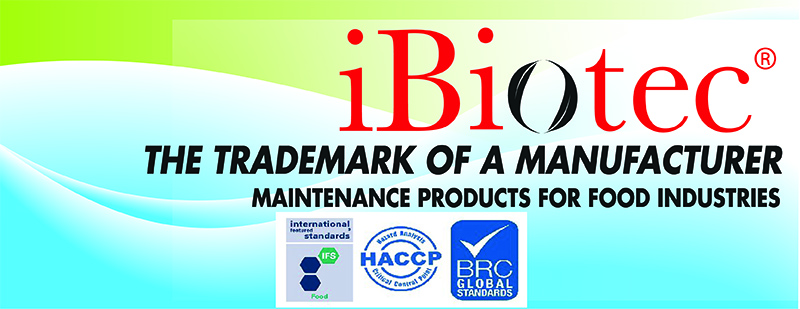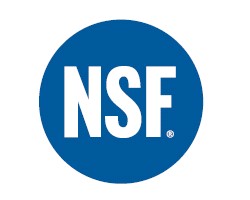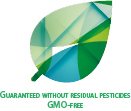
SPECIFIC MAINTENANCE PRODUCTS
AGRI-FOOD
NSF approved
detectable removable equipment
 |
 |
.jpg) |
 |
ACCIDENTAL POLLUTION RISKS
The presence of foreign bodies in food is the primary cause of consumer complaints that can lead to the recall of all products.
The first step in HACCP, BRC Review 8 and IFS control methods is to identify these possible and dangerous (exogenous) foreign bodies, who may cause an illness or injury due to lack of control (Art 14 of the EC Regulation 178/2002 amended in 2003, 2006, 2008, 2009, 2014, 2017 and replaced by EU Regulation 2019/1243 of the European Parliament and of the Council of June 20, 2019)).
Every solid body must therefore be easily detectable, either by visual control for regional craftsmen or by industrial vision in large companies: X-rays, HSI hyperspectral imaging systems, 2D and 3D optical vision, colour contrast detectors, opencv Python software application, based on the hue, saturation and brightness (HSB) colour perception.
The absence of blue foods makes this colour the standard for detection.
iBiotec manufactured NSF products allow this detection. All removable bodies, capsules, caps, covers, diffusers, nozzles, extenders with risk, are blue and detectable.
Frame of Reference
ISO 22,000 management system defining results requirements
HACCP plan defining the implementation of means, based on the principles of the system of analysis of hazards and of critical points
BRC review 8. English system
IFS Franco-German System
BRC and IFS have been developed by and for mass distribution, applicable throughout the chain, from primary production to the point of sale
ISO FSSC 22,000 including ISO 22,000 and BRC or IFS
GMP (Good Manufacturing Practice) BPF (Bonne Pratique de Fabrication) Certification to ensure products are manufactured and delivered in accordance with HACCP rules
and more recently FSMA (U.S. system) Food Safety Modernization Act
Other standards
BRC IoP and NF EN 15593 concerning packaging.
ISO TS 22002 concerning the requirements of the prerequisite programs (PRP) now replaces PAS 220.
GFSI Global Food Safety Initiative.
Halal Certification concerning animal-derived products.
Kosher Label Certification covering the entire manufacturing process.
iBiotec certifies that its products are without any animal-derived substances.
European regulation.
Regulation EC 178.2002
Article 3 obligation of traceability and self-monitoring.
Article 14 no food should enter the market if it is dangerous.
Article 19 sets the responsibility for the operator.
Regulation EC 852.2004
obligations for the system of hazard analysis and critical points.
source economie.gouv.fr DGCCRF
The ANSES (Agence Nationale de Sécurité Sanitaire), the National Agency for Health, Food, Environment and Labour Sagety has drawn up a list of foreign bodies presenting a physical danger in food (Tables 1 - 2 - 3)
ANSES Physical hazards in food
RECOMMENDATION 84/2017 concerning hydrocarbons
acronyms
HC Hydrocarbons
MOSH Hydrocarbons Saturated with Mineral Oils
POSH Polyolefin oligomeric saturated hydrocarbons
MOAH Aromatic Hydrocarbons from Mineral Oils
EFSA European Food Safety Authority
ANSES French National Agency for Food, Environmental and Occupational Health Safety
FASFC Federal Agency for the Safety of the Food Chain (Belgium)
Identified by the EFSA, these HC, MOSH and MOAH substances are food contaminants.
Originally, the most troubling sources of food contamination were printing inks migrating through packaging materials.
In 2017 the European Union published Recommendation 84 requiring Member States to monitor HC in foodstuffs.
A draft ordinance drawn up by Germany is currently being revised (third version) and will result in a regulation (it must be remembered that Germany is the leading European manufacturer of products for food nutrition, and that the IFS standard is a Franco-German system).
At the request of the DGCCRF, the ANSES (referral 2015.SA.0070) issued an opinion dated 08 March 2017.
paragraphs 3 3.1 and 3.4
"It has been established that the origin of MOSH and MOAH during food production also concerns mould release products, lubricants, cleaning products, (and even motor oils from agricultural machinery, or certain pesticides)
paragraphs 3.5.1 and 3.5.2
The toxicological data relating to these contaminants are given in the paragraphs above
WARNING
HC, MOSH/POSH and MOAH content must be quantified. The standard NF EN 16.995 defines the type of analysis.
HPCL/GC then HPCL (FID), dual-channel gas chromatography with flame ionisation detection. This method makes it
possible to quantify the following separately
• MOSH and POSH
• MOAH
Note that it is not possible to separate MOSH and POSH because of their structural similarity. Consequently, when
there are no MOSH, there are no POSH.
The FASFC has defined the action thresholds for mineral oil hydrocarbons. These limit values are different for
different food families.
Commission Regulation (EU) 2021/382
Published on March 4th 2021 at OJEU
amending the Annexes to Regulation (EC) 852/2004
THE FOOD SAFETY CULTURE
BECOMES A REGULATORY OBLIGATION